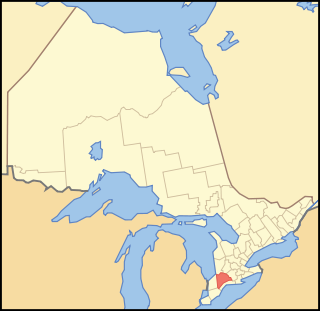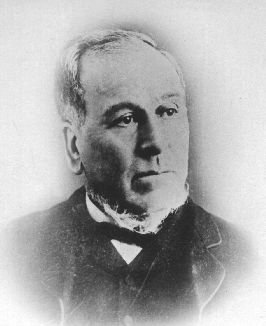
Middlesex County is a primarily rural county in Southwestern Ontario, Canada. Landlocked, the county is bordered by Huron and Perth counties on the north, Oxford County on the east, Elgin County on the south, and Chatham-Kent and Lambton County on the west.

Sir Oliver Mowat was a Canadian lawyer, politician, and Ontario Liberal Party leader. He served for nearly 24 years as the third premier of Ontario. He was the eighth lieutenant governor of Ontario and one of the Fathers of Confederation. He is best known for defending successfully the constitutional rights of the provinces in the face of the centralizing tendency of the national government as represented by his longtime Conservative adversary, John A. Macdonald. This longevity and power was due to his maneuvering to build a political base around Liberals, Catholics, trade unions, and anti-French-Canadian sentiment.

The Manitoba Schools Question was a political crisis in the Canadian province of Manitoba that occurred late in the 19th century, attacking publicly-funded separate schools for Roman Catholics and Protestants. The crisis was precipitated by a series of provincial laws passed between 1890 and 1896, and another passed in 1916.

Hastings County is located in the province of Ontario, Canada. Geographically, it is located on the border of Eastern Ontario and Central Ontario. Hastings County is the second-largest county in Ontario, after Renfrew County, and its county seat is Belleville, which is independent of Hastings County. Hastings County has trademarked the moniker "Cheese Capital of Canada".

The District Municipality of Muskoka, more generally referred to as the District of Muskoka or Muskoka, is a regional municipality in Central Ontario, Canada. It extends from Georgian Bay in the west, to the northern tip of Lake Couchiching in the south, to the western border of Algonquin Provincial Park in the east. A two-hour drive north of Toronto, it spans 6,475 km2 (2,500 sq mi). It has some 1,600 lakes, making it a popular cottaging destination.

Arthur Sturgis Hardy, was a Canadian lawyer and Liberal politician who served as the fourth premier of Ontario from 1896 to 1899.

Renfrew County is a county in the Canadian province of Ontario. It straddles the west bank of the Ottawa River. There are 17 municipalities in the county.

Lennox and Addington County is a county and census division of the Canadian province of Ontario. The county seat is Greater Napanee. It is located in the subregion of Southern Ontario named Eastern Ontario.

Northwestern Ontario is a secondary region of Northern Ontario in the Canadian province of Ontario which lies north and west of Lake Superior and west of Hudson Bay and James Bay. It includes most of subarctic Ontario. Its western boundary is the Canadian province of Manitoba, which disputed Ontario's claim to the western part of the region. Ontario's right to Northwestern Ontario was determined by the Judicial Committee of the Privy Council in 1884 and confirmed by the Canada Act, 1889, of the Parliament of the United Kingdom. In 1912, the Parliament of Canada by the Ontario Boundaries Extension Act gave jurisdiction over the District of Patricia to Ontario, thereby extending the northern boundary of the province to Hudson Bay.
Addington County was a historic county in the Canadian province of Ontario which now forms part of Lennox and Addington County. It was named after Henry Addington, 1st Viscount Sidmouth.
Lennox County is a historic county in the Canadian province of Ontario which now forms part of Lennox and Addington County. It was named after Charles Lennox, 3rd Duke of Richmond.
The Ontario and Quebec Railway (O&Q) was a railway located in southern and eastern Ontario, Canada. It was initially chartered in March 1881 by managers of the Canadian Pacific Railway to run between Toronto and Perth, where it would connect, via a short branch line, to the CPR-controlled Brockville and Ottawa Railway. Construction began in 1882, and the line was completed in August 1884.
Manitoba Municipal and Northern Relations is a department of the Government of Manitoba that deals with local administrations and bodies, including municipalities, planning districts, and non-governmental organizations. This includes the provision of training, ongoing consultation, technical analysis, and funding related to land management, community renewal, infrastructure, and the building of capacity of local governments to provide services.

St Catharines Milling and Lumber Co v R was the leading case on Aboriginal title in Canada for more than 80 years. The Judicial Committee of the Privy Council, affirming a ruling by the Supreme Court of Canada, held that Aboriginal title over land was allowed only at the Crown's pleasure and could be taken away at any time. The case, involving Ojibway Treaty No. 3, which had never been previously litigated before any court, is a leading decision in Canada on the differences between the division of legislative powers and property rights under the Constitution of Canada.

The Local Government Act 1888 was an Act of Parliament which established county councils and county borough councils in England and Wales. It came into effect on 1 April 1889, except for the County of London, which came into existence on 21 March at the request of the London County Council.
The position of Provincial Secretary was particularly important in Manitoba from 1870 to 1874, as that province's institutions were being established. The province had no Premier during this period, and its Lieutenant-Governor acted as the de facto leader of government. The early Provincial Secretaries were the most prominent elected officials in the province, and are retrospectively regarded as Premiers in many modern sources.

William Durie Lyon was a merchant and political figure in Ontario, Canada.

The Short Titles Act 1896 is an act of the Parliament of the United Kingdom. It replaces the Short Titles Act 1892.
Municipal elections in Ontario, a province of Canada, are held every four years. Municipalities in Ontario held an election on 25 October 2010. Prior to 2006, elections were held every three years.

The Housing of the Working Classes Act 1900 was an act of the Parliament of the United Kingdom.














